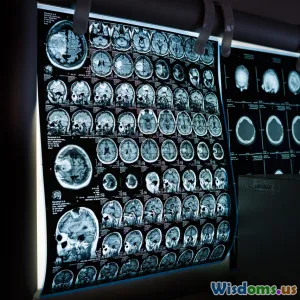
Are Earthquake Prediction Apps Worth Trusting Yet
15 min read Are earthquake prediction apps reliable? Explore their strengths, current limitations, and what the future holds in quake forecasting and public safety. (0 Reviews)
Are Earthquake Prediction Apps Worth Trusting Yet?
Earthquakes strike with little warning, causing devastation in minutes and leaving lasting scars on communities. With headlines frequently featuring apps that claim to alert users before a quake, it's natural to wonder—can your smartphone really warn you about the next big tremor? Are these earthquake prediction apps reliable, or are they simply riding the wave of technological optimism? This article will dig beneath the surface of the promises and pitfalls, exploring not only whether earthquake prediction apps are trustworthy but also their present capabilities, real-world case studies, and the science that underpins them.
The Lure of Instant Alerts
Imagine a world where your phone vibrates moments before an earthquake strikes, giving you and your loved ones precious time to seek safety. In quake-prone regions like Japan, California, and Turkey, such technology seems like an answer to countless prayers. The app stores are full of earthquake predictors, promising everything from early shaking notifications to allegedly outright forecasting the time, place, and magnitude of quakes. But do these claims have a solid scientific footing?
As demand for personal safety tools soars, the popularity of these apps raises critical questions. Can current technology truly predict or provide useful warnings for earthquakes—or are these promises more science fiction than fact?
A Primer: The Science (and Challenge) of Earthquake Prediction
To understand the promise and perils of earthquake prediction apps, it's key to grasp the fundamental science behind earthquake forecasting.
Earthquake Prediction vs. Earthquake Warning
Prediction suggests that we can forecast the time, place, and strength of an earthquake before it happens.
Earthquake early warning (EEW) isn't the same as prediction. Instead, it detects an earthquake already in progress and notifies users seconds before the worst shaking arrives. The distinction is crucial:
- Prediction: "A 7.0 earthquake will hit Los Angeles at 4pm tomorrow." (Currently not possible.)
- Warning: "You have 20 seconds before strong shaking reaches your location." (Increasingly possible.)
Most consumer-facing apps that claim to "predict" earthquakes are actually providing early warning based on real-time detection, not prophecy—and there's a huge scientific difference.
The Science at Work
Earthquakes start deep underground when built-up tectonic stress releases along faults, sending seismic waves through the earth. "Foreshocks" (small quakes) sometimes precede larger events, but rarely enough to form an actionable pattern. The process is so sudden and complex that, as the United States Geological Survey (USGS) asserts, "neither the USGS nor any other scientists have ever predicted a major earthquake."
Types of Earthquake Apps: What’s On Offer?
Apps in this field generally fall into several broad categories, each with different goals and technological underpinnings.
1. Early Warning Apps
Description: These apps tap into official earthquake early warning networks (like Japan's J-ALERT and California’s ShakeAlert system). They receive data from a network of seismic sensors and broadcast alerts to users within seconds of initial quake detection.
Examples:
- MyShake (California): Receives alerts from the ShakeAlert system, providing seconds of warning for moderate to strong shaking.
- Earthquake Network: Uses users' own phones as sensors, crowdsourcing movement data for rapid quake detection.
2. Seismic Activity Monitors
Description: These do not provide forecasts but allow users to monitor global earthquake activity and aftershock data based on USGS and other organizations’ feeds.
Examples:
- QuakeFeed: Offers up-to-date global quake info and maps.
- LastQuake (by EMSC): Focuses on public reports and real-time crowd-sourced data about earthquake experiences and damage.
3. "Quake Prediction" and Anomaly Detection Apps
Description: The most controversial category. These apps sometimes claim to predict earthquakes days or weeks in advance, often using unconventional techniques (magnetometer readings, animal behavior, lunar cycles).
Examples:
- QuakeAlert: Markets itself with predictive capabilities, though skeptics abound.
- Earthquake Predictor Forecast: Leverages algorithms based on past seismic cycles and tidal calculations.
Expert consensus has yet to validate these long-term predictions as scientifically reliable.
How Early Warning Systems Work—and What Apps Can Offer
The Physics of Warning
When an earthquake strikes, it emits both “P-waves” (primary waves) and “S-waves” (secondary waves). While P-waves travel fastest, they are weaker and often imperceptible to humans. S-waves, arriving seconds later, cause more powerful shaking.
Seismic sensors detect the P-waves near the quake epicenter and relay alerts, giving those farther from the epicenter precious seconds (up to about 60, depending on distance and network speed) to act before the S-waves arrive.
Where Apps Fit In
When integrated with official warning networks, apps can push warnings directly to users’ smartphones, as push notifications or SMS. In places like Japan, this has become standard—but execution varies worldwide depending on local infrastructure.
Real-World Impact
- Japan: The nation’s Earthquake Early Warning System launches nationwide alerts via phone, broadcast, and public systems—credited with saving lives in the 2011 Tōhoku quake and more recent events.
- California: ShakeAlert, accessible via apps like MyShake, gave users up to 10 seconds warning during 2022’s Ridgecrest quake—enough to drop, cover, and hold on. A Los Angeles Times analysis found that, while the window is brief, even a few seconds matters: “About 90% of injuries could be prevented if people take cover before shaking starts.”
- Mexico City: The SASMEX seismic alarm network isn’t app-based but has issued audible warnings for decades, providing a vital template.
These warning systems are impressive technological feats, with day-to-day limitations tied not to smartphone apps themselves, but sensor placement, data latency, and the unpredictable behavior of earthquakes.
Debunking the Myth: True Prediction Still Out of Reach
No Forecasting Silver Bullet
Despite decades of research, no app—or algorithm—has reliably predicted the day, time, or place of a major earthquake in advance. The USGS, EMSC, and most seismologists widely emphasize that earthquake prediction in the absolute sense remains impossible. And yet, markets overflow with apps advertising (in vague or misleading terms) their ability to “forecast” destructive events.
A Closer Look at Why
- Complex Fault Systems: Tectonic activity isn’t regular; earthquakes can come in clusters, aftershocks, or be separated by centuries, seemingly regardless of prior patterns.
- Lack of Precursor Signals: Reliable, measurable indicators (like gas emissions or electromagnetic spikes) haven’t shown consistent predictive value at large scales.
- False Alarms and Social Impact: In the few cases where preliminary signals triggered warnings (such as China’s 1975 Haicheng quake), false or missed alarms led authorities to scale back predictions due to the societal cost of panic and economic disruption.
The Controversial “Prediction Apps”
Several commercial apps and companies tout the use of AI, animal patterns, or environmental data to predict quakes. While intriguing, these methods lack peer-reviewed validation or replicate success in multiple regions.
- Case Study: The QuakeFinder project, which placed magnetometers along California faults in hopes of spotting electromagnetic anomalies before quakes, has so far yielded no actionable predictive success—despite over a decade of data gathering.
- Pseudoscience Alert: Some apps base warnings on lunar cycles or planetary alignments, concepts repeatedly debunked by mainstream geology.
The Pros and Cons of Today’s Earthquake Apps
What Works
- Seconds Matter: Early warning systems can buy seconds to drop, cover, and hold on—materially lowering injury risks.
- Psychological Readiness: Even non-predictive apps keeping users informed of seismic risks can spur better disaster preparedness overall.
- Crowdsourced Verification: Apps like LastQuake improve situational awareness by collating user-reported data on shaking, damage, and aftershocks.
What Falls Short
- Coverage Gaps: Networks only cover certain areas; many rural or cross-border communities lack sensors.
- Latency: App warning times depend on the speed of data relay; dense networks outperform others, but lag and connectivity issues limit reach.
- False Security: Over-promising prediction can create complacency or panic when warnings don’t align with reality.
- Privacy Risks: Some sensor apps collect motion or location data, potentially raising privacy concerns.
User Experience—The Mixed Record
Many users in California have praised apps like MyShake, but anecdotal frustrations persist—from warnings arriving late or after a quake, to missed notifications entirely. As earthquake scientist Dr. Lucy Jones notes: “Early warning is not forecasting. It’s remarkable, but it’s not a crystal ball.”
Signals of Progress: Where the Technology Is Going
Researchers and technologists are working hard to close the gap between wishful thinking and reality in quake detection.
Integrated Sensor Networks and IoT
Future networks will fuse government, university, and public smartphone sensors to create ultra-dense alert systems. In Mexico, low-cost “raspberry shake” devices have broadened detection coverage, while California’s MyShake app uses crowdsourced accelerometer data for auto-validation of events.
Advances in Machine Learning
AI can sift vast sets of seismic and non-seismic data, highlighting correlations undetectable by humans. While machine learning hasn’t created a prediction model, researchers like Stanford’s EQ Transformer project are making early warning algorithms faster, more sensitive, and less error-prone.
Public Education
The proliferation of these apps is increasing public engagement with seismic safety. More people are learning to "get under a sturdy table" because quake warnings have become part of daily awareness—a crucial culture shift in preparedness.
Putting It All Together: Are Earthquake Apps Worthy of Your Trust?
The answer, perhaps infuriatingly, is both yes and no.
- Trust Early Warning Apps—Judge Claims of Prediction Skeptically: If your local region is covered by a reputable early warning network (like ShakeAlert, Japan's J-ALERT, or the EMSC in Europe), having an app such as MyShake is a practical, sensible move—just as carrying home insurance makes sense even when disaster can't be precisely forecast. The time gained is limited, but it can make a real difference.
- Be Skeptical of Predictive Claims: No institutionally backed app can predict the specific timing or location of future earthquakes days in advance. Question bold claims, especially apps that offer "exclusive algorithms" but provide no explanation of their methods. In some cases, false alarms or missed predictions can be dangerous.
Best Practice: Use verified, official apps to receive early warnings, combine them with time-tested preparedness steps, and maintain realistic expectations about what today's technology can—and can’t—do.
Conclusion: An Ongoing Shake-Up
Earthquake prediction remains the holy grail of geophysics, a challenge that still eludes even the most powerful supercomputers and extensive sensor networks. While some consumer apps may wander into pseudoscience, early warning apps tightly integrated with robust sensor networks are proving their worth, saving lives and building a more prepared public.
Are earthquake prediction apps worth trusting? The answer depends in large part on what you expect: off-the-shelf prophecy is still a mirage, but practical, life-saving warning delivered in real time via your device is already here in certain parts of the world.
Until true prediction advances further, stay earthquake-ready, keep a vetted warning app on your phone, and don’t be swayed by miracle claims. Prepare—not just your digital life, but your family—for when the ground shakes. The final warning may only ever be measured in seconds, but in an earthquake, those seconds truly count.
Rate the Post
User Reviews
Popular Posts















